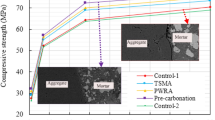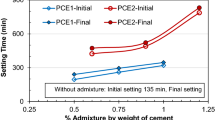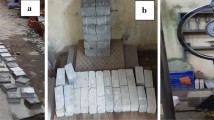Abstract
CA mortar, as a cushion layer widely used in ballastless slab track, is a complex composite material. Apart from the mix proportions, mixing process is also a very important factor affecting the properties. In this paper, the influences and mechanisms of a novel mixing process (NMP), in which premixed cement mortar was mixed with water and superplasticizer firstly then all other liquid components, on properties of the fresh and hardened Type II CA mortar were investigated as compared to the traditional mixing process (TMP), in which the cement mortar was mixed into the mixed liquid components. The results confirmed that the CA mortar prepared by using NMP showed a less water and less superplasticizer requirement than that by using TMP. A much lower air content (below 6.0%) during mixing, no bleeding and segregation during hardening were also interestingly observed while using NMP. However, the air content reached as high as 15.0% and at least 3.0% CSS must be incorporated to avoid bleeding & segregation during hardening while using TMP. Through foaming experiments, it was found that there exists foam-boosting effect in the mixed system of superplasticizer and emulsifier, and that is why a very high air content was observed while using TMP, in which the superplasticizer and asphalt emulsion was mixed together before mixing with cement mortar. For the CA mortar prepared by using NMP, no foam-boosting effect was observed, typically because the superplasticizer molecules were absorbed onto the cement particles before the asphalt emulsion was incorporated.










Similar content being viewed by others
References
Ando K, Sunaga M, Aoki H, Haga O (2001) Development of slab tracks for Hokuriku Shinkansen line. Quarterly Report of RITI 42(1):35–41
Coenraad E (2003) Recent developments in slab track. Eur Railway Rev 9:81–85
Coenraad E (1997) Innovations in railway track. Rail Technology Advancements in the Netherlands, TU Delft
Coenraad E (1999) Slab track: a competitive solution. Rail Int 6:32–46
D N. Bilow, G M. Randich, Slab track for the next 100 years, In: Proceedings of the annual technical conference- American Railway Engineering and Maintenance of Way Association, 2000, Dallas, TX, pp 117–136
Jin SH, Chen XF, Yang J (2006) Key technologies of CA mortar for slab track (in Chinese). China Railway Sci 27(2):20–24
Zhang YR, Kong XM, Hou SS, Liu YL, Han S (2012) Study on the rheological properties of fresh cement asphalt paste. Constr Build Mater 27:534–544
Chinese Railway Specification (2008) Technical specification of cement emulsified asphalt mortar for CRTSII slab ballastless track (in Chinese). China Railway Publishing, House, Beijing, China
Liu J, Zheng X, Li S, Ding R, Zeng Z, Weng Z (2015) DejunYang, Effect of the stabilizer on bubble stability and homogeneity of cement emulsified asphalt mortar in slab ballastless track. Constr Build Mater 96:135–146
Peng JW, Deng DH, Yuan Q, Liu ZQ, Fang L (2014) Study of the rheological behavior of fresh cement emulsified asphalt paste. Constr Build Mater 66:348–355
Ouyang J, Han BG, Cao Y, Zhou WJ, Li WG, Shah SP (2016) The role and interaction of superplasticizer and emulsifier in fresh cement asphalt emulsion paste through rheology study. Constr Build Mater 125:643–653
Ouyang J, Tan YQ (2015) Rheology of fresh cement asphalt emulsion pastes. Constr Build Mater 80:236–243
Guo H, Wang Z, Liang Q, Li G (2022) Improvement of stability and mechanical properties of cement asphalt emulsion composites using nano fibrillated celluloses. Cem Concr Comp 125:104330
Yuan Q, Zuo S (2020) DehuaDeng, Early-age deformation of cement emulsified asphalt mortar with aluminum powder and expansive agent. Constr Build Mater 260(10):120484
Leiben Z, Wang X, Wang Z, Yang Bo, Tian Y, He R (2018) Damping characteristics of cement asphalt emulsion mortars. Constr Build Mater 173(10):201–208
Zeng XH, Xie YJ, Deng DH (2012) Conductivity behavior of the fresh CA mortar and its relationship with the fluidity properties. Constr Build Mater 36(10):890–894
Le THM, Park DW, Seo JW (2019) Evaluation on the mechanical properties of cement asphalt mortar with quick hardening admixture for railway maintenance. Constr Build Mater 206:375–384
Qiang W, Peiyu Y, Ruhan A, Jinbo Y, Xiangming K (2011) Strength mechanism of cement-asphalt mortar. J Mater Civil Eng. 23(9):1353–1359
Rutherford T, Wang ZJ, Shu X, Huang BS, Clarke D (2014) Laboratory investigation into mechanical properties of cement emulsified asphalt mortar. Constr Build Mater 65:76–83
Jahanbakhsh H, Hosseini P, Nejad FM, Habibi M (2019) Intermediate temperature fracture resistance evaluation of cement emulsified asphalt mortar. Constr Build Mater 197:1–11
Xie YJ, Fu Q, Zheng KR, Yuan Q (2014) Dynamic mechanical properties of cement and asphalt mortar based on SHPB test. Constr Build Mater 70:217–225
Nejad FM, Habibi M, Hosseini P, Jahanbakhsh H (2017) Investigating the mechanical and fatigue properties of sustainable cement emulsified asphalt mortar. J Cleaner Prod 156:717–728
Qiu KC, Chen HS, Ye HP, Hong JX, Sun W, Jiang JY (2013) Thermo-mechanical coupling effect on fatigue behavior of cement asphalt mortar. Int J Fatigue 51:116–120
Shan YC, Zheng SG, Zhang XF, Luo W, Mao JD, Kong DY (2018) Fatigue performance of the CA mortar used in CRTS I ballastless slab track under simulated servicing condition. Materials 11(11):2259
Hu SG, Wang T, Wang FZ, Liu ZC, Gao T, Zou JZ (2009) Freezing and thawing resistance of cement asphalt mortar. Key Eng Mater 400–402:163–167
Le THM, Park DW, Seo JW, Phan TM (2020) Anti-chemical resistance and mock-up test performance of cement asphalt mortar modified with polymer for ballast stabilizing. Constr Build Mater 232:117260
Tan Y, Ouyang J, Lv J, Li Y (2013) Effect of emulsifier on cement hydration in cement asphalt mortar. Constr Build Mater 47:159–164
Liu B, Liang D (2017) Effect of mass ratio of asphalt to cement on the properties of cement modified asphalt emulsion mortar. Constr Build Mater 134:39–43
Du SW (2014) Interaction mechanism of cement and asphalt emulsion in asphalt emulsion mixtures. Mater Struc 47(7):1149–1159
Fang L, Zhou J, Yang Z, Yuan Q, Que Y (2022) Interaction between cement and asphalt emulsion and its influences on asphalt emulsion demulsification, cement hydration and rheology. Constr Build Mater 329:127220
Wang FZ, Zhang YH, Liu YP, Tao T, Zou JZ, Chen L (2009) Preliminary study on asphalt emulsion used in cement asphalt mortar. J Test Eval 37(5):483–485
Hu SG, Wang T, Wang F-Z, Liu Z-C (2009) Adsorption behavior between cement and asphalt emulsion in cement–asphalt mortar. Adv Cem Res 21(1):11–14
Ouyang J, Lijun Hu, Li H, Han B (2018) Effect of cement on the demulsifying behavior of over-stabilized asphalt emulsion during mixing. Constr Build Mater 177(20):252–260
Zeng XH, Xie YJ, Deng DH (2013) A study of the mixing of cement and emulsified asphalt mortar. Mag Concr Res 65(21):1255–1264
Duan FT, Wang T (2013) Influence of mixing process on the properties of cement emulsified asphalt mortar for CRTS II slab (in Chinese). Railway Eng 7:103–105
Xinghua Zeng, Mix ratio design and performance of CA mortar for CRTS-II slab track (in Chinese), Master’s Dissertation, Wuhan University of Technology, 2009.
Li YL, Tan YQ, Ouyang J, Wang JF (2011) Study on influencing factors of flow-ability of cement asphalt mortar. Adv Mat Res 243–249:4240–4243
Honggui Hu, Mix ratio design and mixing process optimization of CA mortar for slab ballastless track (in Chinese), Master’s Dissertation, Zhejiang Univ Technol, 2012.
Ouyang J, Tan YQ, Corr DJ, Shah SP (2016) Investigation on the mixing stability of asphalt emulsion with cement through viscosity. J Mater Civ Eng 28(12):04016149
Kong DY, Corr DJ, Hou PK, Yang Y, Shah SP (2015) Influence of colloidal silica sol on fresh properties of cement paste as compared to nano-silica powder with agglomerates in micron-scale. Cem Concr Comp 63:30–41
Chiocchio G, Paolini AE (1985) Optimum time for adding superplasticizer to Portland cement pastes. Cem Concr Res 15:901–908
Aiada I, Abd El-Aleemb S, El-Didamony H (2002) Effect of delaying addition of some concrete admixtures on the rheological properties of cement pastes. Cem Concr Res 32:1839–1843
Day K (1999) Concrete mix design, quality control and specification, 2nd edn. E & FN Spon, London, p 202
Petkova R, Tcholakova S, Denkov ND (2012) Foaming and foam stability for mixed polymer–surfactant solutions: effects of surfactant type and polymer charge. Langmuir 28(11):4996–5009
Osei-Bonsu K, Shokri N, Grassia P (2015) Foam stability in the presence and absence of hydrocarbons: From bubble- to bulk-scale. Colloids Surf A: Physicochem Eng Aspects 481:514–526
Ma K, Li P, Wang Zi, Chen Y, Campana M, Doutch J, Dalgliesh R, Maestro A (2022) Robert K Thomas, Jeff Penfold, Strong synergistic interactions in zwitterionic–anionic surfactant mixtures at the air–water interface and in micelles: The role of steric and electrostatic interactions. J Colloid Interface Sci 613:297–310
Petkova B, Tcholakova S, Chenkova M, Golemanov K, Denkov N, Thorley D, Stoyanov S (2020) Foamability of aqueous solutions: role of surfactant type and concentration. Adv Colloid Interface Sci 276:102084
Taylor DJF, Thomas RK, Penfold J (2007) Polymer/surfactant interactions at the air/water interface. Adv Colloid Interface Sci 132(2):69–110
Acknowledgements
The authors gratefully acknowledge the financial support from the National Natural Science Foundation of China (52178256).
Author information
Authors and Affiliations
Contributions
YZ: Investigation, Data processing, Writing- original draft. GH: Investigation -Microstructure observation, writing. HH: Investigation, Data processing. CZ: Investigation, Data processing. DK: Investigation, Data processing, Writing—review & editing, PI.
Corresponding author
Ethics declarations
Conflict of interest
The authors declare that they have no known competing financial interests or personal relationships that could have appeared to influence the work reported in this paper.
Additional information
Publisher's Note
Springer Nature remains neutral with regard to jurisdictional claims in published maps and institutional affiliations.
Supplementary Information
Below is the link to the electronic supplementary material.
Supplementary file1 (MP4 35,757 kb)
Rights and permissions
Springer Nature or its licensor (e.g. a society or other partner) holds exclusive rights to this article under a publishing agreement with the author(s) or other rightsholder(s); author self-archiving of the accepted manuscript version of this article is solely governed by the terms of such publishing agreement and applicable law.
About this article
Cite this article
Zhang, Y., He, G., Hu, H. et al. Influences and mechanisms of mixing process on properties of the fresh and hardened Type II cement asphalt (CA) mortar. Mater Struct 56, 167 (2023). https://doi.org/10.1617/s11527-023-02259-w
Received:
Accepted:
Published:
DOI: https://doi.org/10.1617/s11527-023-02259-w




